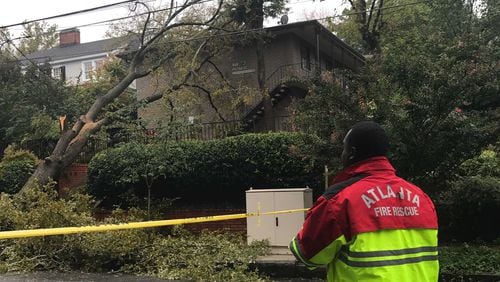Atlantans love their City in a Forest. But, when stormy weather moves in, those towering pines and shady oaks can come crashing down, destroying lives and property.
Two people were killed by falling trees this week as Tropical Storm Irma battered the metro area. In the days since, the rev of chainsaws has become a familiar sound to residents as crews work around the clock to remove trees and limbs from roads, yards, homes and cars.
“The equivalent in Atlanta to oceanfront property, which is dangerous during hurricanes, is forest-front property,” said Neil Norton, executive director of the Georgia Arborist Association. “Much of Atlanta is forest-front property.”
Stephanie Galer of Grant Park discovered the hazards of forest-front living first-hand on Monday when three giant tulip poplars on her street came down, clipping her house and destroying much of her neighbor’s home.
Despite the close call, Galer said she won’t be advocating for the removal of any more trees.
“If I could do it again, I would put a tulip poplar back up again in every single one of our yards,” she said. “It’s part of what makes the neighborhood so special.”
Atlanta is among the few large cities that regulate tree removal on private property. Of the city’s estimated nine million trees, about 77 percent are on private land. Any tree larger than six inches in diameter must be approved for removal by the city’s Arborist Division.
In neighboring Cobb County, no permit is needed to remove trees from private residential property in most cases. DeKalb and Gwinnett counties place some restrictions on cutting certain types of large trees.
The day after Irma struck, the city's planning department issued directions for storm repairs, including tree removal, intended to expedite recovery.
If a tree has fallen, no permitting is required, but property owners should take photos of the tree before removal. In the case of trees that are in danger of falling and imminently hazardous, property owners should contact the city’s Arborist Division for verbal or written authorization to remove the tree without a permit.
For Norton, the permitting and documentation process is a small price to pay to preserve Atlanta’s distinct canopy.
“I think it’s well balanced,” he said of the ordinance, adding that it is the responsibility of property owners to have their trees regularly assessed and trimmed or removed as needed.
Bob Delbridge, owner of 404-CUT-TREE, isn’t a fan of Atlanta’s tree removal ordinance. He describes it as “unconstitutional.”
“It’s the people that decide whether to have trees or not, not the government,” Delbridge said. “People get most incensed about it.”
Still he dismisses the idea that the ordinance contributed to the pain and suffering of Irma.
“I don’t see the tie between the regulations and storm damage,” Delbridge said. “About 70 percent of the trees that fall on houses have a defect that could have been spotted before the storm came and those trees would have been permitted by the city.”
Even healthy trees can come down in tropical storm winds, he added.
Advocates and many arborists say the city’s regulations are necessary to protect trees that contribute to the overall health of the city.
Greg Levine, co-executive director of Trees Atlanta, a conservationist organization, said trees help mitigate flood risk, clean the air, keep temperatures low, filter water and provide habitat for wildlife.
“Having some regulation over it is, in our belief, a good thing,” he said. “They are huge assets to the community.”
About the Author







